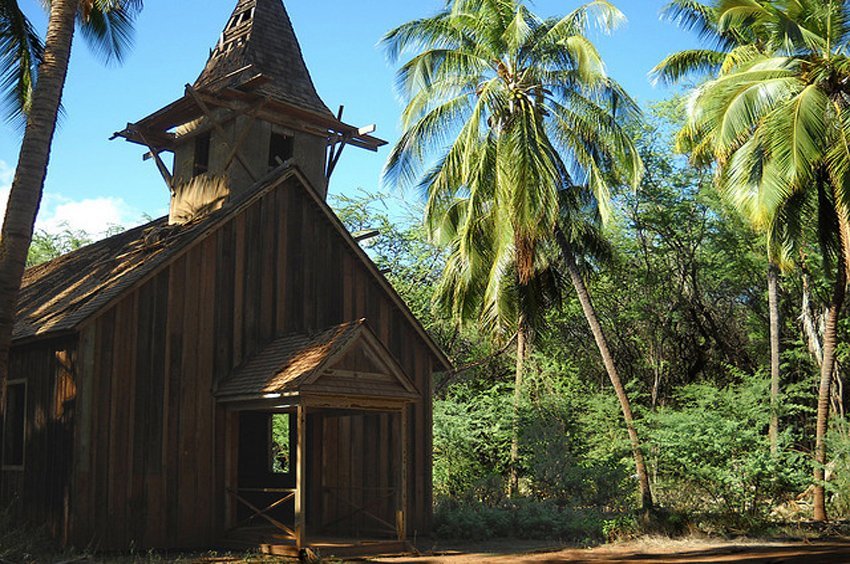Keomuku

Keomuku is a historic coastal area on Lanai's eastern shore, once a thriving sugar plantation town in the late 1800s. Originally settled by fishermen and farmers, Keomuku later became home to over 500 workers with homes, a pier, and a railroad. After a plague and water contamination, the village was abandoned. Today, visitors can explore its tranquil beaches, remnants of old buildings, and the preserved Malamalama Church amid peaceful ocean views.
Keomuku, Lanai
Keomuku is located on the east shore of Lanai. During ancient times, fishermen and farmers settled along the coastal portions of this area up to the valley of Maunalei. Keomuku was a small and sleepy fishing village up until 1899, when the Maunalei Sugar Company moved in, turning the village into a bustling sugar plantation.
Over 500 workers, primarily Japanese, were brought here to work in the sugar cane fields. Additional housing structures, a pier and a railroad were built, and the harvested sugar cane was shipped to Maui, where it was milled. The sugar industry at Keomuku was thriving until 1900, when the plague that began in Honolulu on neighboring Oahu, hit the village.
Lanai's plantation workers were hit hard. But it got even worse for the Maunalei Sugar Company, when the freshwater sources that were used to irrigate the fields turned brackish. This forced the company to shut down its operations in 1901.
There is another story that explains why the Maunalei Sugar Company was forced to shut down. According to a local legend, the sugar operation was successful until the company built the railroad along the coast, damaging the sacred stones of a nearby heiau (Hawaiian temple). The Hawaiians believed that this angered the gods and that this is the reason why the sugar mill’s drinking water turned salty and the population was wiped out by an epidemic.
Today, Keomuku lies abandoned and is called a ghost town by some. Little remains of the village and there is little evidence that once a thriving sugar industry was located here. The only structures that are left standing are a few old wooden houses and the original structure of the Ka Lanakila o Ka Malamalama Church, which was completed in 1903. It is the last structure that is still intact in the village. Also still there is a small locomotive and its tracks (look for the sign that leads to it).
To reach Keomuku, take Keomuku Road or route 430. Expect six miles (9.7 km) of crystal clear waters along the narrow black detrital sand beach and only peace and quiet. Though there are no tourist facilities in Keomuku (most visitors to the island don't come out here), the area offers sheer natural beauty and teeming ocean life, which makes it great for nature lovers, fishermen and beachcombers. On the shore on either side of the village are the remains of two of Lanai's ancient Hawaiian fishponds. The pond walls can only be seen at low tide.
Key Features of Keomuku
- Historic plantation town: Once home to the Maunalei Sugar Company and 500+ workers
- Malamalama Church: Built in 1903 and still standing today
- Ghost town ambiance: Abandoned village with remnants of buildings and sugar industry equipment
- Legend of the heiau: Local folklore attributes the town's decline to damage done to sacred temple stones
- Remote and peaceful: Great for nature lovers, beachcombers, and history enthusiasts
- Population: Uninhabited
- Zip code: 96763
Frequently Asked Questions
What happened to Keomuku's sugar plantation?
The Maunalei Sugar Company shut down in 1901 due to a plague and brackish water sources. A local legend also blames the damage to sacred heiau stones for its downfall.
What is the Malamalama Church?
The Ka Lanakila o Ka Malamalama Church is a wooden structure built in 1903, still standing today as the last intact building from the Keomuku village era.
Can I swim or snorkel at Keomuku?
Keomuku offers clear waters and scenic views, but it's best suited for beachcombing and sightseeing rather than swimming due to the lack of facilities and remote location.
How do I get to Keomuku?
Take Keomuku Road (Route 430) from Lanai City. The area is isolated, so bring water and supplies. Be aware there are no facilities or signage once you arrive.
















